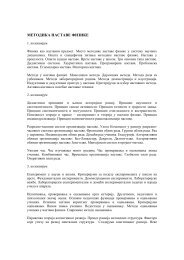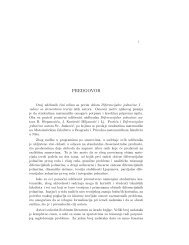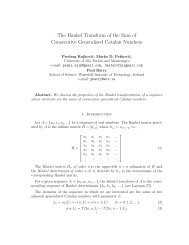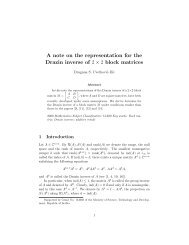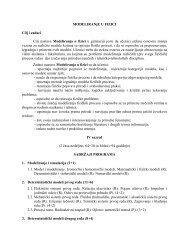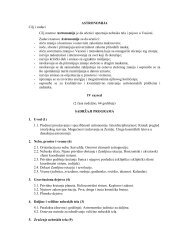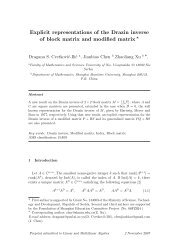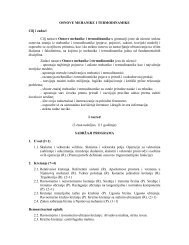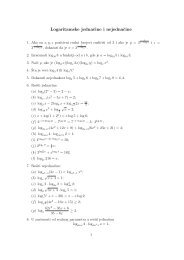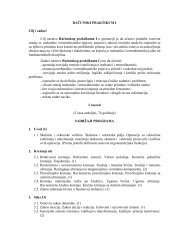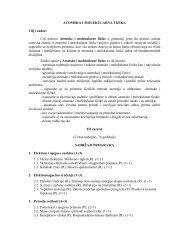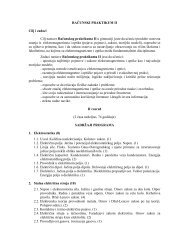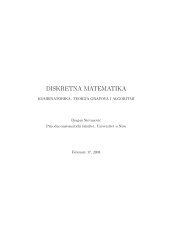On weighted reverse order laws for the Moore-Penrose inverse and ...
On weighted reverse order laws for the Moore-Penrose inverse and ...
On weighted reverse order laws for the Moore-Penrose inverse and ...
Create successful ePaper yourself
Turn your PDF publications into a flip-book with our unique Google optimized e-Paper software.
E. Boasso, D. S. Cvetković-Ilić, R. Harte 2<br />
In <strong>the</strong> frame of rings with involution, J. J. Koliha, D. Djordjević <strong>and</strong> D. Cvetković extended<br />
<strong>the</strong> characterization of [4] under <strong>the</strong> additional assumption of <strong>the</strong> ∗-left cancellation<br />
property of a particular elment of <strong>the</strong> ring, see [7].<br />
The first objective of <strong>the</strong> present article is to study a generalization of <strong>the</strong> <strong>reverse</strong> <strong>order</strong><br />
law <strong>for</strong> <strong>the</strong> <strong>Moore</strong>-<strong>Penrose</strong> <strong>inverse</strong>, namely, given R a ring with involution <strong>and</strong> a <strong>and</strong> b ∈ R<br />
such that a, b <strong>and</strong> ab are <strong>Moore</strong>-<strong>Penrose</strong> invertible, to characterize when <strong>the</strong> following identity<br />
holds:<br />
(ab) † = cb † a † ,<br />
where c ∈ R is such that c commutes with b <strong>and</strong> b ∗ . This identity <strong>and</strong> o<strong>the</strong>rs presented in<br />
section 2 will be called <strong>weighted</strong> <strong>reverse</strong> <strong>order</strong> <strong>laws</strong> <strong>for</strong> <strong>the</strong> <strong>Moore</strong>-<strong>Penrose</strong> <strong>inverse</strong>.<br />
Naturally, when c = e a characterization of <strong>the</strong> usual <strong>reverse</strong> <strong>order</strong> law is obtained. Fur<strong>the</strong>rmore,<br />
o<strong>the</strong>r similar generalizations of <strong>the</strong> <strong>reverse</strong> <strong>order</strong> law <strong>for</strong> <strong>the</strong> <strong>Moore</strong>-<strong>Penrose</strong> <strong>inverse</strong><br />
in rings with involution <strong>and</strong> in complex algebras with involution will be also considered, see<br />
next section. To this end, some ideas of [2] will be recovered. Note that no additional<br />
assumption such as <strong>the</strong> ∗-cancellation property <strong>for</strong> elements of <strong>the</strong> ring is needed.<br />
<strong>On</strong> <strong>the</strong> o<strong>the</strong>r h<strong>and</strong>, given a C ∗ -algebra A, a ∈ A <strong>and</strong> K ⊆ {1, 2, 3, 4}, an element x ∈ A<br />
is said to be a K-<strong>inverse</strong> of a, if x satisfies <strong>the</strong> <strong>Moore</strong>-<strong>Penrose</strong> equation (j) <strong>for</strong> each j ∈ K.<br />
In [3] several <strong>reverse</strong> <strong>order</strong> <strong>laws</strong> <strong>for</strong> K-<strong>inverse</strong>s of products of two C ∗ -algebra elements were<br />
characterized. The second objective of this work to extend <strong>the</strong> results of [3] to prime rings<br />
with involution including <strong>the</strong> <strong>weighted</strong> case, see section 3.<br />
Be<strong>for</strong>e going on, several definitions <strong>and</strong> some notation will be recalled.<br />
Let R be an associative ring with unit element e. The ring R is said to be a prime ring, if<br />
given a <strong>and</strong> b ∈ R such that aRb = {0}, <strong>the</strong>n 0 ∈ {a, b}. For example, if H is a Hilbert space<br />
<strong>and</strong> R = L(H), <strong>the</strong> algebra of all operators defined on <strong>and</strong> with values in H, <strong>the</strong>n it is not<br />
difficult to prove that R is a prime ring, see [1, Lemma 3] <strong>for</strong> <strong>the</strong> case of complex matrices.<br />
An element a ∈ R is said to be group invertible, if <strong>the</strong>re exists b ∈ R such that<br />
aba = a, bab = b, ab = ba.<br />
It is well known that if a ∈ R is group invertible, <strong>the</strong>n <strong>the</strong>re is only one group <strong>inverse</strong> of a,<br />
see [8]. When a ∈ R has a group <strong>inverse</strong>, it will be denoted by a ♯ .<br />
An involution ∗ : R → R is an anti-isomorphism of degree 2, that is<br />
(a ∗ ) ∗ = a, (a + b) ∗ = a ∗ + b ∗ , (ab) ∗ = b ∗ a ∗ .<br />
An element a ∈ R is said to be Hermitian, if a = a ∗ . In addition, a is said to be <strong>Moore</strong>-<br />
<strong>Penrose</strong> invertible, if <strong>the</strong>re exists b ∈ R such that a <strong>and</strong> b satisfy <strong>the</strong> <strong>Moore</strong>-<strong>Penrose</strong> <strong>inverse</strong><br />
equations presented above.<br />
It is well known that given a ∈ R, <strong>the</strong>re is at most one <strong>Moore</strong>-<strong>Penrose</strong> <strong>inverse</strong> of a, see<br />
[10]. When <strong>the</strong> <strong>Moore</strong>-<strong>Penrose</strong> <strong>inverse</strong> of a ∈ R exists, it will be denoted, as be<strong>for</strong>e, by a † .<br />
In addition, R † will st<strong>and</strong> <strong>for</strong> <strong>the</strong> set of all <strong>Moore</strong>-<strong>Penrose</strong> invertible elements of a ∈ R. Note<br />
that if a ∈ R † , <strong>the</strong>n aa † <strong>and</strong> a † a are hermitian idempotents. What is more, if a ∈ R † , <strong>the</strong>n<br />
a † ∈ R † <strong>and</strong> (a † ) † = a. Moreover, it is easy to prove that a ∈ R † if <strong>and</strong> only if a ∗ ∈ R † .<br />
Fur<strong>the</strong>rmore, in this case, (a ∗ ) † = (a † ) ∗ . In what follows, (a † ) ∗ will be denoted by a †∗ .



